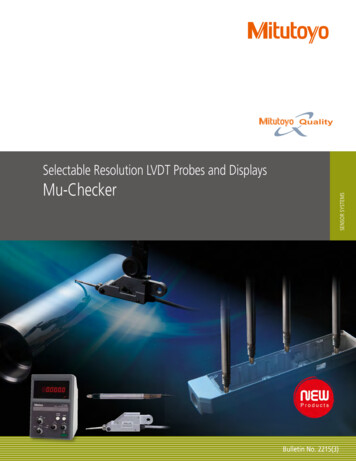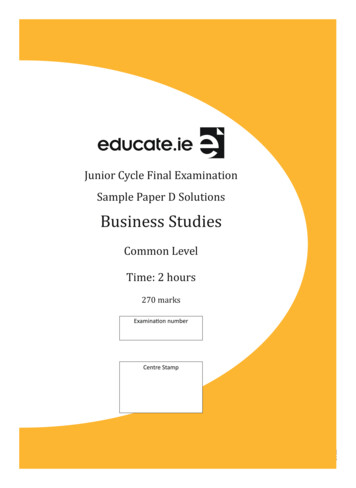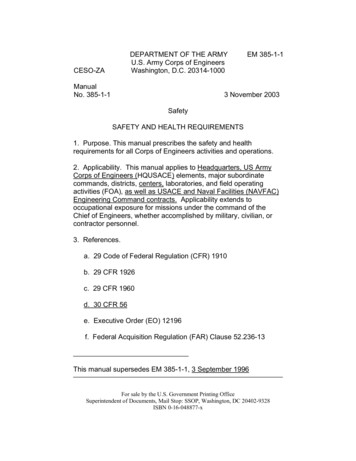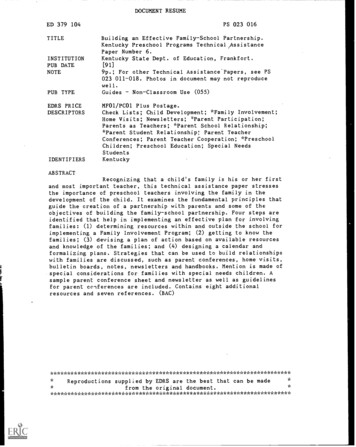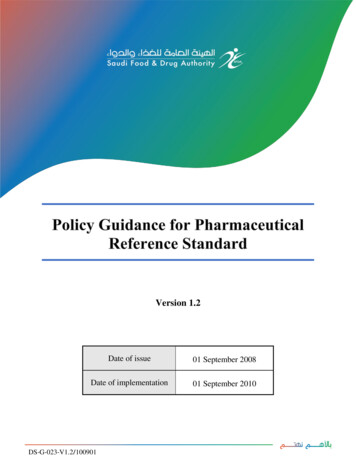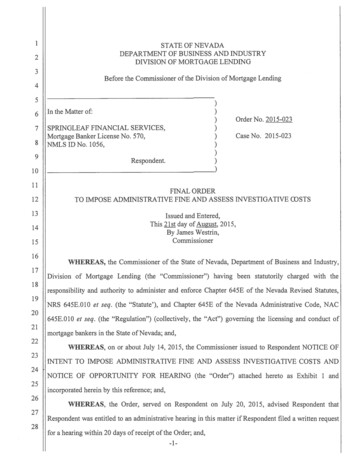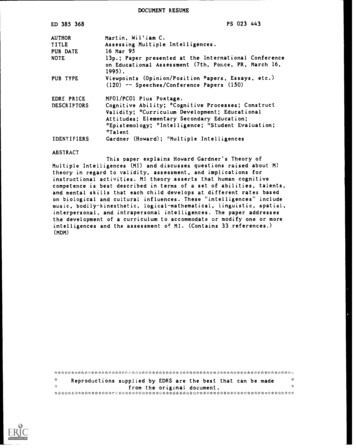
Transcription
DOCUMENT RESUMEPS 023 443ED 385 368AUTHORTITLEPUB DATENOTEMartin, Wil'.iam C.PUB TYPEViewpoints (Opinion/Position papers, Essays, etc.)Speeches/Conference Papers (150)(120)EDRE PRICEDESCRIPTORSMFO1 /PCO1 Plus Postage.Assessing Multiple Intelligences.16 Mar 9513p.; Paper presented at the International Conferenceon Educational Assessment (7th, Ponce, PR, March 16,1995).Cognitive Ability; *Cognitive Processes; ConstructValidity; *Curriculum Development; EducationalAttitudes; Elementary Secondary Education;*Epistemology; *Intelligence; *Student Evaluation;*TalentIDENTIFIERSGardner (Howard); *Multiple IntelligencesABS1RACTThis paper explains Howard Gardner's Theory ofMultiple Intelligences (MI) and discusses questions raised about MItheory in regard to validity, assessment, and implications forinstructional activities. MI theory asserts that human cognitivecompetence is best described in terms of a set of abilities, talents,and mental skills that each child develops at different rates basedon biological and cultural influences. These "intelligences" includemusic, bodily-kinesthetic, logical-mathematical, linguistic, spatial,interpersonal, and intrapersonal intelligences. The paper addressesthe development of a curriculum to accommodate or modify one or moreintelligences and the assessment of MI. (Contains 33 **A*******************************1,Reproductions supplied by EDRS are the best that can be madefrom the original ********************
U S DEPARTMENT OF EDUCATIONEDUCATIONAL RESOURCES INFORMATIONaNTER,ERICXsTrTa it,c,rhoh! hat, nee,q,Multiple Intelligences1()FRIIt Tt.tItASSESSING MULTIPLE INTELLIGENCESbyWilliam C. Martin, Ph.D.College of EducationThe University of West FloridaPensacola, Florida, U.S.A.Position Paper PresentationSeventh International Conference onEducational AssessmentHosted by the University of Puerto RicoPonce, Puerto RicoMarch 16, 1995Supported by theUnited States TeaKwonDo AllianceBert D. Kollars, TaeKwonDo Master & President14I'ft N T'I iTE ;44;IIA HI IMATEkN,rt.,;i"I\).Ck1/41BEST COPY AVAILABLE71E2
Multiple Intelligences2IntroductionEducationalWhen considering the theme of this conference,Assesspent, I saw this as an opportunity to present an alternateapproach to conventional assessment of the young learner'sHoward Gardner's Theory of Multipleintellectual development.Intelligences seemed to be an appropriate vehicle to demonstrate toyou an alternate means of assessing the development of the younglearner. He developed this theory as a developmental psychologistImplementing this theory into theat the Harvard University.curriculum and assessing student achievement is the central concernof this presentation.QUESTIONSIn order to examine this theory, questions have to be posed:What are these multiple intelligences?How do we apply this theory into practical application in ourcurriculum and instructional programs?How do we assess this diversity of intelligences?PURPOSEThe specific purpose of this presentation will be pleofSpeculate with you about implementing this theory intothe classroom. Training in TaekwonDo Plus will be the vehiclefor demonstrating the application of the ences.theandimplications of this theory.conceptExplain theportfolio method.ofauthenticlearningDefine and institute authentic HESISThe younglearners have intellectual capacitiescompletely accommodated in existing educationalassessment procedures.thatareprogramsnotand
Multiple Intelligences3ASSUMPTIONSBased on the human condition of diversity students have an innateand basic need to learn.All cultures have the capacity to some degree, in some unique way,to provide the opportunity for the development of their youth'sintelligence.Parents instinctively will nurture their youth's physical andintellectual development.The beliefs, attitudes, and value system of a culture demand thefostering of the conditions eminent to its youths, development,with a concomitment to those things that they cherish.Assessment becomes essential for both the learner and the educator,if understanding of our efforts to develop the young learner are tobe achieved.THE ARGUMENTwhat do the cultural anthropologists say about theintelligence of humanity?They say that intelligence can bestudied by considering the cognitive developmental process, thebiological basis, the child-rearing influences, the cultural opportunities, the IQ tests, the effects of economic deprivation onminorities, the system of moral judgments, the differences inraces, and so on.First,I would like to deal exclusively with Gardener's work based on aninvestigation of human potential which I felt was in keeping withthe theme of this conference.His work at Harvard seemedparticularly important to viewing alternate assessment strategies.He deals with human cognitive capacities among human diversity andthe implications for educational policies and practices throughoutthe educational enterprise.What is the idea of multiple intelligence that Gardner refers to?It is a new theory of human intellectual competencies.Gardner'stheory challenges the traditional views of intelligence that wehave been taught to believe from our graduate training in learningtheories or have been subjected to by our educational systems. Histheory is not de nova.Gall, Wundt, James, Piaget, Binet, andothers all worked on understanding human intelligence.Vygotskygave the world of scholars a strong signal about the usefulness ofthe IQ tests when he said, "IQ tests fail to yield any indicationof an individual's zone of potential development."4
Multiple Intelligences4What, then, is Gardener's viewpoint of intelligence?Gardener and his confreres believe that human cognitive competenceis better described in terms of a set of abilities, talents, ormental skills, which are called "intelligences." All normal youthpossess each of these skills to some extent; but by virtue ofgenetic development and cultural influence, children differ inGardner also believestheir profile of skills and combinations.his theory of intelligence is more vertical than thetraditional linear theories and more humane as it includes more ofour youth and it more closely resembles human intellectual behaviorthatWhat constitutes this M/I theory?M/I theory is framed in light of the biological origins of eachGardner considered those skills that are universalFurther; biological andto all members of the human species.cultural influences were combined when studying a mental activityHe uses the example of language as a global skill, "faculty," or"intelligence"; that is, language may manifest itself in oneculture in the form of writing, as oratory in another, and as aform of cryptology in a third. Another global capacity is spatialability.In one society, it may manifest itself in navigation,hunting in a second, and geometric reasoning in a third, orsculpture in a fourth.mental faculty.Gardener further pointsoutthattheaimofidentifyingintelligences which are rooted in biology and valued by cultures isto discover an "intelligence." Several sources from studies ofgifted to cross-cultural studies of cognition have been examined.A criterion for intelligence is discussed at length in Gardner'sFrames of Mind (1983).or set of operations.Each intelligence has an identifiable coreto you how Gardner explains his seven"intelligences," based on tha Thfoimation thDt I have reported toyou thus far.Let me briefly reportMUSICMusic is an intelligence; that is, certain parts of the brain playan important role in the perception and the production of music.These areas of the brain are located in the right hemisphere.Acertain set of mental skills comes into play in the child,iftalented, because of a biological underpinning and a proclivity fora particular intelligence--in this case, music.Supporting thisdefinition is evidence that certain types of brain damage, such asamusia, constitute an isolated loss of musical intelligence.
Multiple Intelligences5BODILY-KINESTHETICBodily-kinesthetic intelligence refers to the ability to use theBallet dancers, athletes, andwhole body or various limbs.They have ainstrumentalists are examples of this intelligence.If this person wereskill in the use of the motor cortex.to suffer apraxia, the development of this intelligence would beseriously impaired. Again, the theory @f separate intelligences issupported with a biological basis. I would like to expand on thisintelligence later in our session using the martial arts as avehicle for the development of that cal intelligence deals with an intelligence thatwon't go into the details, as we are allIproblem solves.others who historically andfamiliar with Piaget's work andThis line oftraditionally define this frame of intelligence.thinking is reproduced into standardized instruments such as I Qtests.LINGUISTICLinguistic intelligence, another global denominator of our youth,is reproduced into a symbol system and, like logical-mathematicalintelligence, is historically and traditionally defined and treatedin the same way, again, the I Q test.SPATIALSpatial intelligence, deriving from the right hemisphere of thebrain, requires a set of skills to solve space-related problems.A person with damage to the right hemisphere has difficulty insolving space-related problems- -another supporting point that thereare domains of intelligence within the brain and implications forus, as curriculum and instructional workers, to consider.INTERPERSONALInterpersonal intelligence builds upon a core capacity to noticedistinctions among others--moods, temperaments, motivations, and soforth.The person with an intelligence in this area may read theintentions and the desires of others where others are oblivious.This intelligence manifests itself in an advanced form among theclergy, politicians, teachers, and some parents who are beingraised by precocious teenagers. TaeKwonDo Plus will be the vehiclefor demonstrating this intelligence.6
Multiple Intelligences6INTRAPERSONALIntrapersonl intelligence is the ability to access one's feelingsand emotions and a capacity to discriminate among these feelingsand emotions in order to understand one's own behavior. Both theinter- and intrapersonal faculties pass the test of being anintelligence. They both feature problem-solving endeavors. BothInterpersonal intelligenceare manifested in a symbol essionintelligence is symbolized in the internal world of dreams.TaeKwonDo Plus training will be used aaain to demonstrate thedevelopment of this intelligence.SUMMARY OF GARDNER'S MODELevidence from brain research, developmental andIn summary,evolutionary investigations, and cross-cultural comparisons broughtto bear in Gardener's search for relevant human intelligences. Anintelligence was included only if reasonable evidence to supportGardenerits membership was found across these diverse fields.believes that these multiple human faculties, "the intelligences,"are to a significant extent independent of one another. Researchon the brain- damaged adults continually supports the position thatThisparticular faculties can be lost while others are spared.independence of the intelligence implies that a high level ofability in one intelligence does not require a similarly high levelin another intelligence.One radical implication of the M/I theory is that such capacitiesare better thought of in a vertical manner. Traditional views placehuman abilities in a horizontal fashion rather than a generalfaculty called memory.Until now, we have supported the fiction that our youth depend onthe blooming of a single intelligence. According to the culturalanthropologist, nearly every cultural role of any degree ofForsophistication requires a combination of intelligences.example,to become a successfulportrait artist requires acombination ofintelligences with onebeingthedominantFor those of us who areintelligence, in this case, spatial.evaluators, it is paramount to assess the particular combination ofskills that may earmark an individual for a certain vocation.APPLICATIONThe theory of M/I faces two distinct directions:the world ofeducational psychology and the other world that you and I work in.To the educational psychologist, it presents a theoretical analysisin an effort to explain the variety of human accomplishments. To
Multiple Intelligences7the world of evaluation, it provides a framework whereby we maybetter cope with the melange of individual differences.ASSESSING MULTIPLE INTELLIGENCESLet me report to you a critique of the theory.Students can be differentiated cn the extent to which they are"at promise" in one or more of the intelligences. The martialarts using specifically TaeKwonDo Plus training will providethe example for such assessment.Standardized instruments can provide a rough-and-ready measureof intellectual potential and achievement in the linguisticand logical-mathematical domains but are irrelevant to theThe whole notion of assessingother intellectual domains.heuristic or interpersonal intelligences chrough short answerThere is an urgent need for modes ofquestions is absurd.assessment which are "intelligence fair."antoThere needs to be a shift from standardized testsemphasis on projects as a means of determining studentThe project will provide the student anachievement.Projectsopportunity to develop the dominant intelligence.can be identified for these intellectual domains.Schools need to attend to all the intelligences.We canprovide our youth with opportunities to develop theirintelligences whether at school, home, or in the community.We need to take heed at the postsecondary level as well. Acollection of projects in a portfolio for every student'sdossier would have equivalent predictive value as the narrowlySuch projects may be moreframed standardized test.motivating and educational.Idon't think tha'Iam suggesting an Utopian curricularactivity. I favor these shifts in curriculum and instructionbecause they follow from the newest research in th cognitiveand neural sciences. Based on the M/I theory, our best chanceto solve global problems is to foster among our global youththe development of a variety of intelligences.What Are the Issues for Educational Assessment?iusic, body-kinesthetic, etc.) are what mostcall talents or gift.Why confuse the issue by renaming them"intelligences"?Intelligences (i.e.,The word intelligences was used to tie-in with the cognitivepsychologists who feel that logical reasoning and linguistics are
Multiple Intelligences8different information processing activities than solving a problemin music theory.Is M/I Really a "Theory"?M/I doesn't consider all data since this would beThe theory is a synthesis of the specialofneurology,offeringspsychometrics, anthropology, evolution, and so on--these fields doControlledsupport that the theory puts it on the right track.experiments could either confirm or disconfirm M/I; for example, atest of the independence of these intelligences by testing theuniversality of intelligences across cultures among our globalyouth or a test of the stability of an intelligence.The theory isaimed at discovering a small set of human faculties that arebiologically valid and give assessment workers something useful toundergird educational activities.Assessing The Effects of the Theory?We need to work together on conceptualizing the application of thistheory to our task as evaluators; cluster our efforts in surveyidentify variables to dofrom our survey studies,studies,correlational studies, and last, design experimental studies tocontrol the examination of the variables dealt with in thecorrelational studies.How Do We Measure M/I Intelligence?We need to develop reliable tests to measure these intelligences.We cannot rely on short answers but instead must develop materialsfor each of these domains. Tests of spatial intelligence, such aswe develop in the architect, would examine spatial relationshipsand the student's ability to analyze construction problems, nThere is, I might add, a concern overmathematical reasoning.separating the "g" (general intelligence) out when testing for aspecific M/I intelligence. If the attempt to assess intellectualpropensities in our global youth is successful, we can deal with"g" much more articulately.What Are the Curriculum and InstructionalImplications for Classroom Activities?We need to determine the determine what intelligence is dominantand performs as the executive intelligence.Then develop aportfolio of activities relative to their unique intellectualcapacities.In order to accomplish the formerwe need resourcesand materials to enhance a particular intelligence.,
Multiple Intelligences9Why Is Moral or Spiritual IntelligenceNot Considered?Walters and Gardener seeitas part of inter-intra- personalintelligence with a cultural value component added.deal with abilities which grow outofaIntelligencesculture rather thanreligious values which can be valued one way or another.Ibelieve that one of the greatest intelligences is the gift ofI am sure chat I could muster considerable support fromprophecy.those of you who are futurists.Can We Develop a Curriculum to Accommodateor Modify One or More Intelligences?Yes! Some intelligences will have a floor and ceiling over others.However, barring brain damage, an individual can achieve in adomain other than his or her executive intelligence and achieveThe Suzuki method and other "hot house"significant results.techniques have proven this. However, materials and instructionalmethods will be crucial. Plus, the surrounding culture will playa prepotent role in determine the extent to which an individual'sintellectual potential is realized.ASSESSING MULTIPLE INTELLIGENCES1.Identifying the Intelligences.2.Assessment Paradigms.3.Student Behavior Log.4.Student Behavior Log Scoring.5.Criteria of Authentic Assessment.6.Examination Structure.7.Academic Design.8.Grading and Scoring.9.A Model for Metacognition Process-folios.10. Stages of Learning Transfer.Wherever possible the TaeKwonDo Plus training will be used as thevehicle for operationalizing the points listed above.
Multiple Intelligences10Assessment ReferencesBellemere, B. (1991). The Scarborough K-8 non-graded model.(Eric Document Reproduction Service No. ED 333 984)Blythe, T., Gardner, H. (1990). A school for allintelligences. Educational Leadership 47(7), 33-37.(1978).Bredemeier, M. E., & Bredemeier, H. C.Sherman Oaks, CA: Alfred.in education.Brim,Social forcesConstancy and change(1980).0. G., Jr., & Kagan, J.in human development. Cambridge, MA: Harvard UniversityPress.Dana, T. M., & Tippins, D. J.(1993). Considering alternativelearners. Middle Schoolassessments for middle levelJournal, 25(2), 3-5,Egan, K., & Gardner, H. (1992). An exchange: The unschooledmind: How children think and how schools should teach.Teachers College Record 94(2), 397-407.Framework for teaching thinking.Leadership, 42(8),Galloway, C. M.(Ed.).(1984).(1986).EducationalTheory Into Practice,23(1).Gardner, H. (1993). Educating for understanding. AmericanSchool Board Journal, 180(7), 20-24.Gardner, H. (1993). Multiple intelligences: The theory intopractice. New York: Basic Books.(1994). Intelligences in theory and practice: Aresponse to Elliot W. Eisner, Robert J. Sternberg, andHenry M. Levine. Teachers College Record 95(4), 576-583.Gardner, H.Gardner, H., & Hatch, T. (1989). Multiple intelligences go toEducationalimplications of the theory ofschool:multiple intelligences. Educational Researcher 18(8), 49.(1992).CCD: A model comprehension program forchanging thinking and instruction. Journal of Reading,George, J. E.35(7), 564-570.Hebert, E. A. (1992). Portfolios invite reflection--fromstudents to staff. Educational Leadership, 49(8), 58-61.11.
Multiple Intelligences11Hoerr, T. R. (1992). How our school applied multipleintelligences theory. Educational Leadership 50(2), 6768Kornhaber, M., Krechevsky, M., & Gardner, H. (1990). ntelligence testing. Educational Psychologist 25(3-4),177-179.Kornhaber, M., & Gardner, H. (1993). Varieties of excellence:Identifying and assessing children's talents. A series onauthentic assessment and accountability. (Eric DocumentReproduction Serlrice No. ED 363 396)(1991). Seven ways of teaching: The artistry ofIL:intelligences.Palatine,Skylight PublishersLazear, D. G.teaching with multipleLazear, D. G. (1992). Teaching fol multiple intelligences.Bloomington, IN: Phi Delta Kappa Educational Foundation.(1994).Marital Arts as aMartin, W. C. and Carlton, J.Vehicle to Enhance Social Competency Among Pre and uary, 1995.Martin, W. C. & Ncube, M. M.(1994, April).The Transfer ofTraining to Field-Based Environments for ion Annual Meeting, New Orleans, 1994.Martin, W. C. and Carlton, J.(1992).Self-esteem as apredictor of achievement among pre and early adolescents.Presentation made at the annual meeting of the UnitedStates Taekwondo Alliance, Bi/fflingham, Alabama, June,1992.Martin, W. C.(1987, July). Multiple Intelligences;CommonDenominators of our Middle-School Youth.(Chair),Symposium-Fostering Personal Development in A Complex,Interactive World.International Council on Educationfor Teaching, Thiety-Fourth World Assembly, Eindhoven,The Netherlands.Martin, W. C.(1986).Multiple Intelligences:CommonDenominators of Our Global Youth.World Council forCurriculum and Instruction Fifth Triennial Conference.Conference Abstracts. HiroFcim-, Japan.12
Multiple Intelligences12Multiple-Intelligences:(1986, November).Martin, W. C.Common Denominators cf our Middle School Youth. NationalSocial Science Association, Tampa, FL.Martin, W. C.Models.27-33.Transferring the Learning of Teaching(1981).The Journal of Social. Studies Reserach. 5(1),(Eds.).Munroe, R. H., Munroe, R. L., & Whiting, B. B.Handbook on cross-cultural human development.(1981).New York: Garland.Notes on educational implications of the theory ofmultiple intelligences: Prepared for the College Board(1986, June 17). Harvard Project Zeroby Howard Gardner.and Boston Veterans Administration Medical Center.Shearer, C. B., & Jones, J. A. (1994). The validation of theHillside Assessment of Perceived Intelligences (HAPI): nces. Paper presented at the annual meeting ofNewthe American Educational Research Association,Orleans, LA. (Eric Document Reproduction Service No. ED372 077)Walters, J. (1992). Application in multiple intelligences:(EricDocumentResearch in alternative assessment.Reproduction Service No. ED 349 812)& Gardner, H. (1990). Domain projects asassessment vehicles in a computer rich environment.(Eric Document ReproductionTechnical Report No. 5.Service No. ED 324 367)Walters, J.,The theory of multiple intelligences:(1985).Walters, J. M.In R. Sternberg & R. WagnerSome issues and answers.(Eds.), Practical intelligence: Origins of competence inCambridge: Cambridgethe everyday world (pp. 1-36).University Press.(1986).The developmentWalters, J. M., & Gardener, H.In Essays on theand education of intelligences.Research report prepared for theintellect (pp. 1-21).Berard Van Leer Foundation of The Hague, the SpencerFoundation of Chicago,and the Carnegie Corporation ofNew York.13
ED 385 368 PS 023 443. AUTHOR. Martin, Wil'.iam C. TITLE. Assessing Multiple Intelligences. PUB DATE. 16 Mar 95. NOTE 13p.; Paper presented at the International Conference. on Educational Assessment (7th, Ponce, PR, March 16, 1995). PUB TYPE Viewpoints (Opinion/Position papers, Essays, etc.) (120) Speeches/Conference Papers (150) EDRE PRICE .
